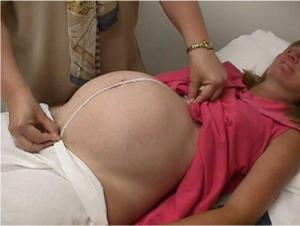|
OBGYN Skills Lab
Pregnant Abdomen Exam Video
Pregnancy is a time of dramatic physiologic change.
Of the pregnancy changes, the enlarging maternal abdomen is the most visible and requires special examination skills. Beginning after the 12th week of pregnancy, the uterus is palpable above the pubic symphysis. Anatomic landmarks are associated with different stages of pregnancy. To accommodate the enlarging uterus:
Before examining the pregnant patient, it can be useful to review her medical records and current data, such as weight, blood pressure, and lab values. Before touching the patient, wash your hands. In some situations, protective gloves may be needed. It is best to fully expose the abdomen. This allows for visualization of skin changes, fetal movement and contractions. Whenever a pregnant patient lies on her back, compression of her vena cava by the pregnant uterus may cause hypotensive symptoms, restlessness, uneasiness, shortness of breath or fainting. Moving the patient to her side will resolve these symptoms within a few seconds. Click Here to watch the video. To relax the patient and relieve anxiety, I usually start the exam by listening to the fetal heartbeat. Ultrasound imaging can also be used. Common skin changes include the linea nigra and stretch marks. Small umbilical hernias, while common, are usually without symptoms. Using a tape measure, note the distance from the symphysis to over the top of the fundus. This is called the fundal height. MacDonald's Rule says that the fundal height in centimeters should equal the weeks of gestation, from midpregnancy to near term.
The uterus is normally non-tender and soft. It is easiest to feel for contractions at the fundus. If there is any question about contractions, electronic fetal monitoring is very sensitive at detecting them. The 1st of four Leopold maneuvers is to palpate the fundus, determining whether the fetus is oriented vertically or transversely, and whether there is a firm head or soft breech in the fundus. Palpate the sides of the uterus during the 2nd Leopold maneuver, to determine on which side is the smooth fetal back and which side has the bumpy fetal arms and legs. During the 3rd Leopold maneuver, determine whether a firm head or soft breech occupies the pelvic inlet and the degree of engagement of the presenting part. In the 4th Leopold maneuver, move above the pelvis and try to determine on which side is the fetal occipital prominence.
|
||||||||||
|
This information is provided by The Brookside Associates, a private organization, not affiliated with any governmental agency. The opinions presented here are those of the author and do not necessarily represent the opinions of the Brookside Associates. For educational simplicity, only one method is usually shown, but many alternative methods may give satisfactory or superior results. This information is provided solely for educational purposes. The practice of medicine and surgery is regulated by statute and restricted to licensed professionals and those in training under supervision. Performing these procedures outside of that setting is a bad idea, is not recommended, and may be illegal. The presence of any advertising on these pages does not constitute an endorsement of that product or service by the Brookside Associates. C. 2010 All Rights Reserved |
 This is the Archived Desktop Edition.
This is the Archived Desktop Edition. 